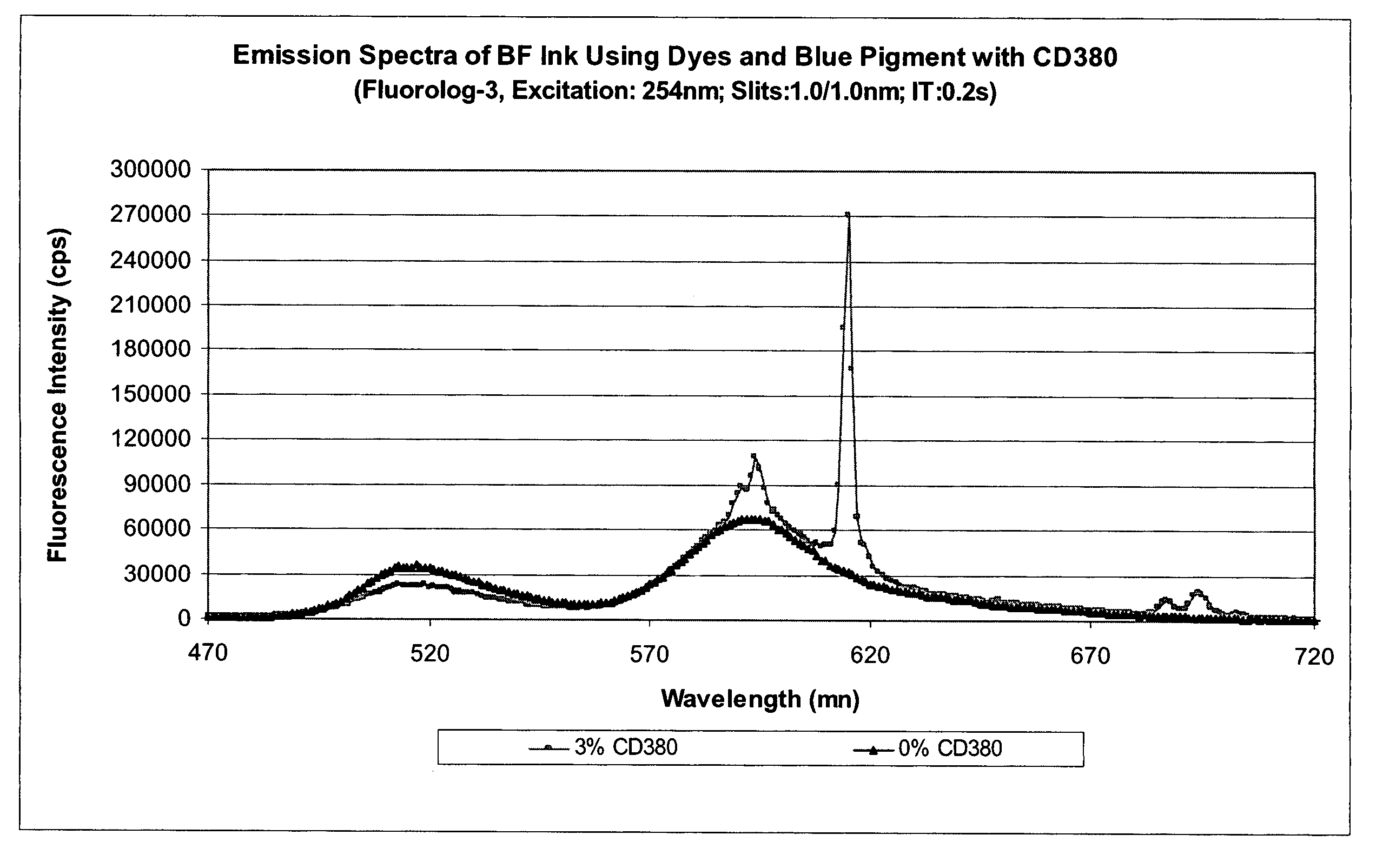Signature protected photosensitive optically variable ink compositions and process
a technology of optical variable ink and signature protection, which is applied in the direction of luminescent compositions, chemistry apparatuses and processes, inks, etc., can solve the problems of not easily detectable, the security feature of the most sophisticated security measures can sometimes be omitted, and the counterfeiting of pov inks is a significant challenge, etc., to achieve high luminescence quantum yield, high luminescence saturation, and characteristic decay rate
- Summary
- Abstract
- Description
- Claims
- Application Information
AI Technical Summary
Benefits of technology
Problems solved by technology
Method used
Image
Examples
example 1
[0076]An ink according to the invention is prepared according to the invention including as an additional security component in the form of a pigment exhibiting two fluorescent bands (one, a broad emission band characteristic of fluorescent colorants in black fluorescent ink and a second distinct, narrow fluorescent emission band due to the presence of a rare earth metal composition, Europium in Lumilux CD380) and phosphorescence due to the rare earth metal composition. This ink is compared to a black fluorescent ink not containing the additional security component.
[0077]
Wt (%)Wt (%)ComponentsComparisonInventionDistilled Water38.0437.76Glycerol1.691.68Ethylene Glycol3.383.35Triethylene Glycol Mono Butyl Ether (BTG)3.283.26Lumikol Red Dispersion26.4226.22Lumikol Orange Dispersion22.6422.47Acryjet Cyan 157 Dispersion4.554.52Lumilux CD 380, rare earth (Europium)00.74compositionTotal100.0100.00Properties of Drawdown and InksPMU, Fluorescence (drawdown)8599PMU, Phosphorescence (drawdown)...
example 2
[0079]A series of inks according to the table below is prepared, varying the concentration of the rare earth specie from 0 to 3% to help illustrate the nature of the difference between the inks of the invention and those capable of providing only visible and fluorescent images.
[0080]
Wt (%)Wt (%)ComponentsComparisonInventionDistilled Water72.0969.93Triethanolamine (TEA)0.310.304 methylmorpholine-N-oxide (MMNO)1.921.865,5-Dimethyl hydantoin formaldehyde5.064.90Triethylene Glycol Mono Butyl Ether (BTG)2.612.53Dodecylbenzene sulfonic acid (DBSA)0.400.39Glycerol8.68.31,2,4-butanetriol4.03.9Acid Yellow 1840.650.63Acid Red 52 (Pylam, 400%)0.800.77Pyranine 120 (Bayer)2.062.00Millijet Blue 28(dye)1.461.41Lumilux CD380, rare earth (Europium)0.003.01compositionTotal100.0100.0Properties of Drawdown and InksPMU, Fluorescence (drawdown)3549PMU, Phosphorescence (drawdown)093OD (drawdown)0.830.80pH7.627.46Viscosity (cp)2.422.59Surface Tension (Dyne / cm)35.134.6
[0081]
FluorescenceIntensity (excitation...
example 3
[0084]Another ink is prepared according to the invention, similar to that in Example 1 compared to a similar ink without the rare earth specie.
[0085]
ComponentsWt (%)Wt (%)Distilled Water65.5563.57Triethanolamine (TEA)0.300.294-methymopholine-N-Oxide (MMNO)1.871.815,5-Dimethyl hydantoin formaldehyde4.924.78Triethylene Glycol Mono Butyl Ether2.542.46(BTG)Dodecylbenzene sulphonic acid0.390.38(DBSA)Glycerol8.378.121,2,4-butanetriol3.893.78Acid Yellow 1840.630.61Acid Red 52 (Pylam, 400%)0.780.76Pyranine 120 (Bayer)2.001.94Acryjet Cyan 157 (blue pigment8.758.48dispersion)Lumilux CD 3800.003.02Distilled Water65.5563.57Total100.0100.0Properties of Drawdown and InksPMU, Fluorescence (drawdown)4254PMU, Phosphorescence (drawdown)085OD (drawdown)0.830.80pH7.547.33Viscosity (cp)2.402.61Surface Tension (Dyne / cm)35.234.1
[0086]The two inks are compared, FIG. 4 showing emission spectra of fluorescence for the ink of the invention at varying concentrations of rare earth specie.
PUM
| Property | Measurement | Unit |
|---|---|---|
| emission band width | aaaaa | aaaaa |
| emission band width | aaaaa | aaaaa |
| emission band width | aaaaa | aaaaa |
Abstract
Description
Claims
Application Information
 Login to View More
Login to View More - R&D
- Intellectual Property
- Life Sciences
- Materials
- Tech Scout
- Unparalleled Data Quality
- Higher Quality Content
- 60% Fewer Hallucinations
Browse by: Latest US Patents, China's latest patents, Technical Efficacy Thesaurus, Application Domain, Technology Topic, Popular Technical Reports.
© 2025 PatSnap. All rights reserved.Legal|Privacy policy|Modern Slavery Act Transparency Statement|Sitemap|About US| Contact US: help@patsnap.com



